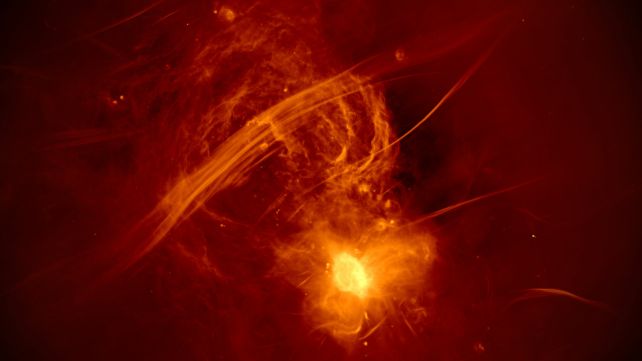Although our galaxy's supermassive black hole is relatively placid, the center of the Milky Way wherein it resides is not a placid place. Its extreme location is rife with what can best be described as shenanigans on an epic scale.
Now it can add a powerful cosmic accelerator known as a PeVatron to its list of japes. An observatory high in the mountains of Mexico has recorded repeated emission of some of the highest-energy gamma rays ever recorded from a single point close to the galactic center.
The nature of this source, named HAWC J1746-2856, is unknown – but, over a period of seven years, the High-Altitude Water Cherenkov (HAWC) observatory recorded 98 gamma-ray events with energy levels exceeding 100 teraelectronvolts.
"These results are a glimpse at the center of the Milky Way to an order of magnitude higher energies than ever seen before," says physicist Pat Harding of Los Alamos National Laboratory.
"The research for the first time confirms a PeVatron source of ultrahigh-energy gamma rays at a location in the Milky Way known as the Galactic Center Ridge, meaning the galactic center is home to some of the most extreme physical processes in the Universe."

PeVatrons are what you get when you mix cosmic rays – mostly charged protons and atomic nuclei streaming through space almost at light speed – and giant, natural particle accelerators. Environments such as supernova remnants, stars being born, and the powerful magnetic fields around supermassive black holes can be PeVatrons.
If the particle accelerator is strong enough, it can accelerate the cosmic rays to extremely high energies, up to teraelectronvolt ranges – that's a trillion electronvolts.
In spite of their power, such high-energy accelerators aren't easy to find.
"A lot of those processes are so rare you wouldn't expect them to be happening in our galaxy, or they occur on scales that don't correlate with the size of our galaxy," Harding explains. "For instance, a black hole eating another black hole would be an event only expected outside our galaxy."
When the accelerated cosmic ray then decelerates suddenly, due to an interaction with something else in space like a magnetic field or a dust cloud, the energy it carries is released in the form of gamma radiation.
Gamma radiation cannot travel very far in Earth's atmosphere, which means we can't detect them directly from the ground.
However, when they enter our atmosphere, their interactions with other molecules distribute their intense energy, breaking them into a shower of harmless, lower-energy particles. These can be detected using underground Cherenkov detectors like HAWC. Physicists can then reconstruct the gamma ray that produced the shower, and even figure out where in the sky it came from.
HAWC is particularly sensitive to teraelectronvolt energies, and it has made several breakthrough detections, including the first detection of TeV gamma rays from the Sun.

A team led by physicist Sohyoun Yu Cárcaron of the University of Maryland found signs of PeVatrons in a wealth of HAWC data collected over 2,546 days. And, interestingly, 98 of those signals seem to have come from the same point source in the center of the Milky Way galaxy.
Named HAWC J1746-2856, the accelerator spits out the most powerful emission ever observed from the galactic center.
The team have yet to narrow down HAWC J1746-2856's identity, with no known supernova remnants coinciding with the source's location. There are two things in that vicinity that could be responsible for the emission – the supermassive black hole around which the galaxy revolves, Sagittarius A*; and a known, but unidentified gamma-ray emitter called HESS J1746-285, near a galactic feature known as the Radio Arc.
Although the researchers were unable to discern the nature of the source, their findings confirm the existence of a PeVatron in the galactic center.
The results tell us a few other things, too. They reveal the cosmic ray density is higher than the galactic average in the galactic center, for example, suggesting a source of freshly accelerated protons in the region.
But we may have to wait for observations from the next generation of Cherenkov detectors to help solve the strange mystery of HAWC J1746-2856.
The research has been published in The Astrophysical Journal Letters.
